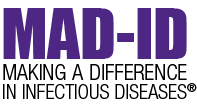Where Are They Now? Q&A with Dr. Samantha Sakdipanichkul
- lwilliams765
- Jul 10
- 2 min read
Updated: Jul 17
By: Cara Slaton, PharmD, BCIDP

Samantha Sakdipanichkul, PharmD, AAHIVP
Dr. Sakdipanichkul is a clinical pharmacist at Memorial Hospital West in Pembroke Pines, Florida. She also completed her PGY-1 residency as well as her PGY-2 residency in Infectious Diseases at Memorial Hospital West. Her interests include HIV/AIDS and antimicrobial resistance.
Dr. Sakdipanichkul presented the following research at the 2024 MAD-ID Conference: Impact of Adding Metronidazole to Cefazolin for Hysterectomy Procedures on Surgical Site Infection Rates.
Dr. Sakdipanichkul and colleagues evaluated whether adding metronidazole to cefazolin surgical prophylaxis reduced surgical site infection (SSI) rates in patients undergoing elective hysterectomies. Outcomes of 904 patients, cefazolin (n=452) and cefazolin plus metronidazole (n=452), were assessed. The addition of metronidazole resulted in a trend towards lower overall SSI rates (1.3% vs 2.9%); however, this result was not statistically significant. In the cefazolin only group, 46% of SSIs grew anaerobes on culture while no anaerobes were grown in the combination group (p=0.03). Additionally, there was a trend in lower 30-day hospital readmission rates in the combination group vs. cefazolin-only group (3.1% vs 5.5%, p=0.07).
What prompted your team to investigate the addition of metronidazole to cefazolin for elective hysterectomies?
At our institution, patients received either cefazolin or cephamycins prior to hysterectomies. Despite this variability in antimicrobial coverage, two of our hospitals experienced an increase in SSIs throughout 2021 prompting our ASP team to implement a pilot program adding metronidazole to cefazolin in hopes of improving patient outcomes.
Did any of your findings surprise you or your team?
Although we knew that identifying such a small difference in SSI rates between groups would be challenging, we had expected the combination group to show a more pronounced improvement. It’s possible that the advantage of combination prophylaxis is more beneficial in specific patients. We intend to conduct further analysis to identify predictors of SSI in order to identify which patients may benefit more from combination prophylactic antibiotics.
Based on your findings, do you recommend changes to current antibiotic prophylaxis guidelines for elective hysterectomy patients?
I would recommend adding metronidazole to cefazolin for hysterectomy procedures because of the numerical decrease in SSI seen in our study. We are in the process of updating our institution protocol to permanently add metronidazole to cefazolin for all hysterectomy procedures.
The MAD-ID ‘Where Are They Now?’ series highlights research presented at the MAD-ID Annual Meeting now published in the infectious diseases literature.




Comments